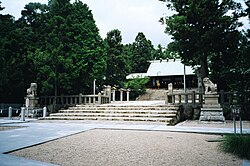Hirota Shrine
| Hirota Shrine 廣田神社 |
|
|---|---|

Main hall
|
|
| Information | |
| Type | Grand Shrine, one of the Nijūnisha |
| Dedicated to | Amaterasu |
| Founded | 3rd century |
| Founder(s) | Empress Jingū |
| Address | 7-7 Taisha-chō, Nishinomiya, Hyōgo prefecture |
| Website | www |
|
|
|
Hirota Shrine (廣田神社 Hirota-jinja?) is a Shinto shrine in Nishinomiya City, Hyōgo Prefecture, Japan. The town's name, "Nishinomiya", means "shrine of the west", and the town is named for Hirota Shrine.
Hirota Shrine is near the bus stop for Hankyu Bus Co., Ltd. and Hanshin Bus Co., Ltd. "Hirota-Jinja-mae".
Hirota Shrine is one of three shrines which, according to Nihon Shoki, a historical epic chronicle, was established by the Empress Jingū in the 3rd century. According to legend, Amaterasu, Goddess of the Sun, and arguably the most important kami in Shinto, spoke to the Empress and declared that she and the other gods of Japan must be enshrined in Hirota, Nagata, Ikuta, and Sumiyoshi. The Empress Consort did as commanded, and then achieved her political ambitions.
The shrine became the object of Imperial patronage during the early Heian period. In 965, Emperor Murakami ordered that Imperial messengers were sent to report important events to the guardian kami of Japan. These heihaku were initially presented to 16 shrines; and in 991, Emperor Ichijō added three more shrines to Murakami's list — including Hirota.
According to the English-language brochure available at the shrine, in the 11th century, under Emperor Shirakawa, Hirota Shrine was designated as "one of the twenty-two honorable shrines in the nation" and given the title "Hirota Grand Shrine". Today it is the only grand shrine in Hyōgo. Others may use the term "taisha" (grand shrine), but they are without the Imperial distinction that sets Hirota Shrine apart.
...
Wikipedia
